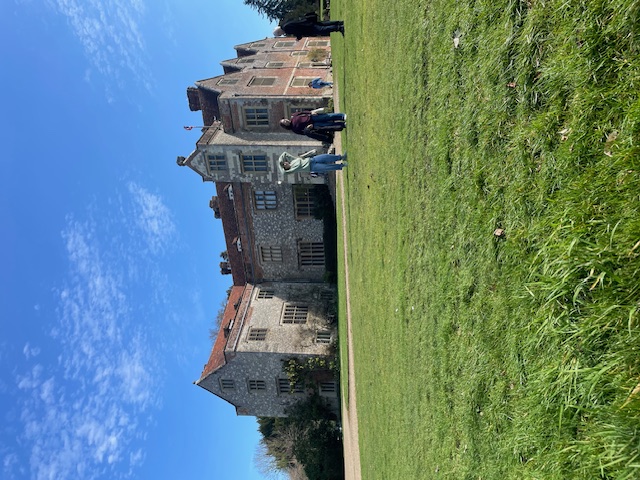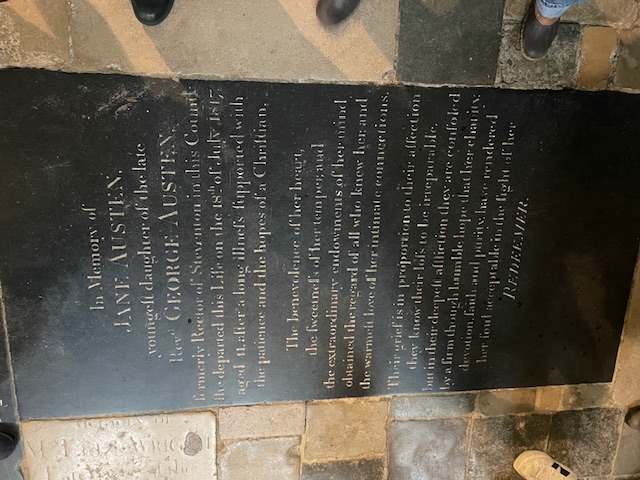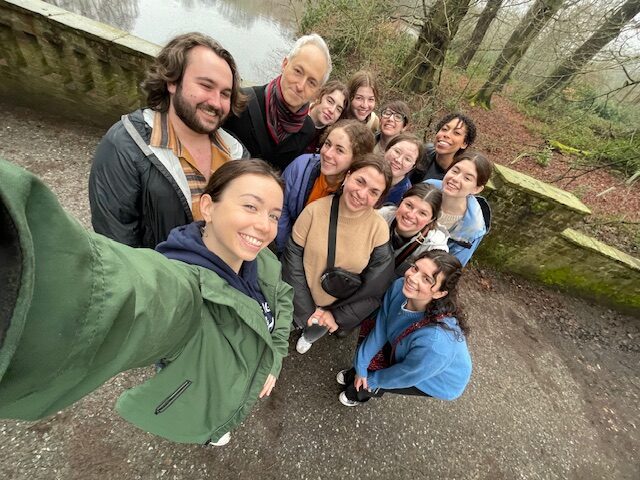Courtesy of Jocelyn Lewis ’24
ENG 493G is a Senior Seminar in English that studies the work and life of Jane Austen. From March 9 to 16 the twelve students and our Professor traveled across the pond to England to see the places, culture, and history that informed Austen’s life and writing. One of the days, a passerby affectionately referred to the group as a motley crew. Motley, and American, as we may have looked—running (sometimes literary) around the UK—the jam-packed trip was a rich experiential educational adventure that provided a new color to the way in which I think about Austen and her writing.
Day Zero:
Our journey began before the crack of dawn. At 3 a.m. on Saturday, March 9, a bunch of English majors and minors boarded a bus to JFK. After traveling through the airport and boarding the plane, we finally arrived, groggy and excited, in London. We hopped on the tube, had some pizza for dinner, and finally got to sleep before our packed schedule began early the next morning.
Day One:
After a breakfast of coffee and beans on toast, our tired and eager crew left the hotel at 9 a.m., our latest morning departure of the trip.
We took the tube, then a double-decker bus, to Strawberry Hill House, an old mock gothic castle belonging to Horace Walpole, the son of Sir Robert Walpole—the first prime minister of the United Kingdom. Horace was a man with eclectic taste, making the visit an exciting attraction. We traveled through colorful, ornately designed rooms, unsure what architectural or design surprise was around the next corner. Volunteers were eager to share their knowledge of each room as we passed through.
Following our visit at Strawberry Hill House we traveled to the Royal Academy to see two excellent exhibits. The first was an exhibition titled “Entangled Pasts” which put historical and contemporary art about empire, colonialism, and enslavement into conversation with one another. We also went to an impressionism exhibit where we saw works by artists such as Degas and Van Gough.
In the evening, we traveled to BFI Southbank, a large cinema complex on the southbank of the Thames River that features a broad range of films. In plushy red seats we kicked back and watched “On Her Majesty’s Secret Service”, the 1969 James Bond film starring George Lazenby and Diana Rigg. While not necessarily related to Jane Austen, the film is a piece of British culture from a different era. The long day concluded with dinner along the Thames River (the London version!) and a good night’s sleep.
Day Two:
Day two in London was also filled with exciting historical and cultural experiences. The day kicked off with a visit to Kenwood House, located in Hempstead. Kenwood House has beautiful sprawling gardens and paths to walk in, so we joined local neighbors (and dogs) in exploring the grounds. Kenwood was the residence of William Murry, the first Earl of Mansfield, and one of the most influential British judges of his time. Through his rulings, he is credited with advancing the country towards the abolition of slavery. While the architecture of the home was striking, built in the neoClassical style, the home’s art collection was equally as impressive, featuring works by artists such as Reynolds, Rembrandt, and Vermeer.
Following our visit to Kenwood House, we traveled back into the heart of London to go to the National Portrait Gallery and the British Museum. The visit to the British Museum included an exhibition on the Roman Army. After a long and informative day of exploring art and architecture that spanned from the 1st century to the 21st century, we concluded the day by eating dinner at an Indian restaurant.
Day Three:
On day three we took the train from Waterloo Station to Winchester. The hour and change through the countryside was charming and a much needed rest from running around the city. In Winchester we visited Winchester Cathedral, where Jane Austen is buried. The cathedral is the longest medieval cathedral in the world and was an important religious and political site during the Middle Ages. The church is also home to the Winchester Bible, a massive unfinished illuminated manuscript. The church has many other important artifacts such as a King James I bible. After our informative tour of Winchester Cathedral we went to the Great Hall, the medieval hall that is home to one of King Aurther’s roundtables. In the afternoon we had some lunch and time to explore the city of Winchester which was both quaint and bustling with activity.

Day Four:
Our second day trip was to the historic, and literary, city of Bath. After boarding the train from Paddington Station, we traveled west towards Bath. We had a packed day in Bath, making stops at the Roman Baths, Bath Abbey, the Assembly Rooms, the Royal Crescent, and finally the Holburne Museum. In Bath we walked along the same streets as Austen and her heroines, and even stopped by the home where Jane and her family lived for five years. While Austen did not seem to write during her family’s time in Bath, her literature often exposes and satirizes the posh and lavish experience of high society in Bath in the late 18th century.
Day Five:
Our final day trip was to the small, but charming, town of Chawton. We got off the train in nearby Alton, and then walked to the remote village. In Chawton we visited Chawton House, the former home of Edward Austen, Jane Austen’s brother, who inherited the home from Thomas and Catherine Knight, relatives of the Austens. As we walked around the sprawling gardens, we saw our first blue sky of the trip. After some time exploring the grounds we walked to a home nestled in town, the Jane Austen House Museum. Austen, her mother, sister, and friend—Martha Lloyd—lived in this home together in Chawton until the end of Jane’s life. It is the home where she wrote her last three novels, Mansfield Park, Emma, and Persuasion. We walked through the wall-paper adorned rooms that the woman ate, slept, and lived in, and we even saw Jane’s writing spot, a small and portable desk that could be moved from room to room.

Day Six:
Our final day was spent in London. Our visit to Westminster Abbey connected much of the history we had been studying throughout the trip. In Poet’s Corner we saw memorials and burial spots to other famous writers such as Geoffrey Chaucer, Aphra Behn, and Samuel Johnson. Following the visit to Westminster we went to the home of Samuel Johnson, a writer and lexicographer, who was famous for writing an expansive dictionary. Our final destination was to St. Paul’s Cathedral where we climbed the winding staircase all the way to the top. At the windy summit, a large and vibrant rainbow emerged from the clouds. It was a beautiful end to such an informative and meaningful trip. The whole class is looking forward to seeing the ways in which our thinking and class discussions around Austen will be enhanced after seeing and learning so much about the society, culture, politics, and history she was situated in.









